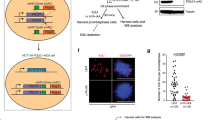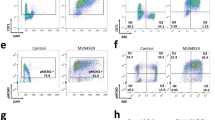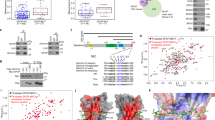Abstract
The APC/C-Cdh1 ubiquitin-ligase complex targets cell cycle regulators for proteosomal degradation and helps prevent tumor development and accumulation of chromosomal aberrations. Replication stress has been proposed to be the main driver of genomic instability in the absence of Cdh1, but the real contribution of APC/C-Cdh1 to efficient replication, especially in normal cells, remains unclear. Here we show that, in primary MEFs, acute depletion or permanent ablation of Cdh1 slowed down replication fork movement and increased origin activity. Partial inhibition of origin firing does not accelerate replication forks, suggesting that fork progression is intrinsically limited in the absence of Cdh1. Moreover, exogenous supply of nucleotide precursors, or ectopic overexpression of RRM2, the regulatory subunit of Ribonucleotide Reductase, restore replication efficiency, indicating that dNTP availability could be impaired upon Cdh1 loss. Indeed, we found reduced dNTP levels in Cdh1-deficient MEFs. Importantly, DNA breakage is also significantly alleviated by increasing intracellular dNTP pools, strongly suggesting that genomic instability is the result of aberrant replication. These observations highlight the relevance of APC/C-Cdh1 activity during G1 to ensure an adequate supply of dNTPs to the replisome, prevent replication stress and the resulting chromosomal breaks and, ultimately, suppress tumorigenesis.
This is a preview of subscription content, access via your institution
Access options
Subscribe to this journal
Receive 50 print issues and online access
$259.00 per year
only $5.18 per issue
Buy this article
- Purchase on Springer Link
- Instant access to full article PDF
Prices may be subject to local taxes which are calculated during checkout








Similar content being viewed by others
References
Teixeira LK, Reed SI . Ubiquitin ligases and cell cycle control. Annu Rev Biochem 2013; 82: 387–414.
Craney A, Rape M . Dynamic regulation of ubiquitin-dependent cell cycle control. Curr Opin Cell Biol 2013; 25: 704–710.
Sivakumar S, Gorbsky GJ . Spatiotemporal regulation of the anaphase-promoting complex in mitosis. Nat Rev Mol Cell Biol 2015; 16: 82–94.
Chang L, Barford D . Insights into the anaphase-promoting complex: a molecular machine that regulates mitosis. Curr Opin Struct Biol 2014; 29: 1–9.
Pines J . Cubism and the cell cycle: the many faces of the APC/C. Nat Rev Mol Cell Biol 2011; 12: 427–438.
Sivaprasad U, Machida YJ, Dutta A . APC/C—the master controller of origin licensing? Cell Div 2007; 2: 8.
Eguren M, Manchado E, Malumbres M . Non-mitotic functions of the Anaphase-Promoting Complex. Semin Cell Dev Biol 2011; 22: 572–578.
Sigrist SJ, Lehner CF . Drosophila fizzy-related down-regulates mitotic cyclins and is required for cell proliferation arrest and entry into endocycles. Cell 1997; 90: 671–681.
Kitamura K, Maekawa H, Shimoda C . Fission yeast Ste9, a homolog of Hct1/Cdh1 and Fizzy-related, is a novel negative regulator of cell cycle progression during G1-phase. Mol Biol Cell 1998; 9: 1065–1080.
Fay DS, Keenan S, Han M . fzr-1 and lin-35/Rb function redundantly to control cell proliferation in C. elegans as revealed by a nonbiased synthetic screen. Genes Dev 2002; 16: 503–517.
Garcia-Higuera I, Manchado E, Dubus P, Canamero M, Mendez J, Moreno S et al. Genomic stability and tumour suppression by the APC/C cofactor Cdh1. Nat Cell Biol 2008; 10: 802–811.
Engelbert D, Schnerch D, Baumgarten A, Wasch R . The ubiquitin ligase APC(Cdh1) is required to maintain genome integrity in primary human cells. Oncogene 2008; 27: 907–917.
Sigl R, Wandke C, Rauch V, Kirk J, Hunt T, Geley S . Loss of the mammalian APC/C activator FZR1 shortens G1 and lengthens S phase but has little effect on exit from mitosis. J Cell Sci 2009; 122: 4208–4217.
Wasch R, Robbins JA, Cross FR . The emerging role of APC/CCdh1 in controlling differentiation, genomic stability and tumor suppression. Oncogene 2010; 29: 1–10.
Zhang J, Wan L, Dai X, Sun Y, Wei W . Functional characterization of Anaphase Promoting Complex/Cyclosome (APC/C) E3 ubiquitin ligases in tumorigenesis. Biochim Biophys Acta 2014; 1845: 277–293.
Munoz S, Mendez J . DNA replication stress: from molecular mechanisms to human disease. Chromosoma 2016; 126: 1–15.
Gelot C, Magdalou I, Lopez BS . Replication stress in Mammalian cells and its consequences for mitosis. Genes (Basel) 2015; 6: 267–298.
Labib K, De Piccoli G . Surviving chromosome replication: the many roles of the S-phase checkpoint pathway. Philos Trans R Soc Lond B Biol Sci 2011; 366: 3554–3561.
Ruzankina Y, Asare A, Brown EJ . Replicative stress, stem cells and aging. Mech Ageing Dev 2008; 129: 460–466.
Lopez-Contreras AJ, Fernandez-Capetillo O . The ATR barrier to replication-born DNA damage. DNA Repair (Amst) 2010; 9: 1249–1255.
Woodward AM, Gohler T, Luciani MG, Oehlmann M, Ge X, Gartner A et al. Excess Mcm2-7 license dormant origins of replication that can be used under conditions of replicative stress. J Cell Biol 2006; 173: 673–683.
Ge XQ, Jackson DA, Blow JJ . Dormant origins licensed by excess Mcm2-7 are required for human cells to survive replicative stress. Genes Dev 2007; 21: 3331–3341.
Ibarra A, Schwob E, Mendez J . Excess MCM proteins protect human cells from replicative stress by licensing backup origins of replication. Proc Natl Acad Sci U S A 2008; 105: 8956–8961.
Zhong Y, Nellimoottil T, Peace JM, Knott SR, Villwock SK, Yee JM et al. The level of origin firing inversely affects the rate of replication fork progression. J Cell Biol 2013; 201: 373–383.
Montagnoli A, Valsasina B, Croci V, Menichincheri M, Rainoldi S, Marchesi V et al. A Cdc7 kinase inhibitor restricts initiation of DNA replication and has antitumor activity. Nat Chem Biol 2008; 4: 357–365.
Poli J, Tsaponina O, Crabbe L, Keszthelyi A, Pantesco V, Chabes A et al. dNTP pools determine fork progression and origin usage under replication stress. EMBO J 2012; 31: 883–894.
Anglana M, Apiou F, Bensimon A, Debatisse M . Dynamics of DNA replication in mammalian somatic cells: nucleotide pool modulates origin choice and interorigin spacing. Cell 2003; 114: 385–394.
Guarino E, Salguero I, Kearsey SE . Cellular regulation of ribonucleotide reductase in eukaryotes. Semin Cell Dev Biol 2014; 30: 97–103.
Hofer A, Crona M, Logan DT, Sjoberg BM . DNA building blocks: keeping control of manufacture. Crit Rev Biochem Mol Biol 2012; 47: 50–63.
Chabes AL, Pfleger CM, Kirschner MW, Thelander L . Mouse ribonucleotide reductase R2 protein: a new target for anaphase-promoting complex-Cdh1-mediated proteolysis. Proc Natl Acad Sci U S A 2003; 100: 3925–3929.
Ke PY, Kuo YY, Hu CM, Chang ZF . Control of dTTP pool size by anaphase promoting complex/cyclosome is essential for the maintenance of genetic stability. Genes Dev 2005; 19: 1920–1933.
Yuan X, Srividhya J, De Luca T, Lee JH, Pomerening JR . Uncovering the role of APC-Cdh1 in generating the dynamics of S-phase onset. Mol Biol Cell 2014; 25: 441–456.
Eguren M, Porlan E, Manchado E, Garcia-Higuera I, Canamero M, Farinas I et al. The APC/C cofactor Cdh1 prevents replicative stress and p53-dependent cell death in neural progenitors. Nat Commun 2013; 4: 2880.
Greil C, Krohs J, Schnerch D, Follo M, Felthaus J, Engelhardt M et al. The role of APC/C(Cdh1) in replication stress and origin of genomic instability. Oncogene 2016; 35: 3062–3070.
Lukas C, Savic V, Bekker-Jensen S, Doil C, Neumann B, Pedersen RS et al. 53BP1 nuclear bodies form around DNA lesions generated by mitotic transmission of chromosomes under replication stress. Nat Cell Biol 2011; 13: 243–253.
Wilhelm T, Magdalou I, Barascu A, Techer H, Debatisse M, Lopez BS . Spontaneous slow replication fork progression elicits mitosis alterations in homologous recombination-deficient mammalian cells. Proc Natl Acad Sci U S A 2014; 111: 763–768.
Teixeira LK, Wang X, Li Y, Ekholm-Reed S, Wu X, Wang P et al. Cyclin E deregulation promotes loss of specific genomic regions. Curr Biol 2015; 25: 1327–1333.
Delgado-Esteban M, Garcia-Higuera I, Maestre C, Moreno S, Almeida A . APC/C-Cdh1 coordinates neurogenesis and cortical size during development. Nat Commun 2013; 4: 2879.
Ayuda-Duran P, Devesa F, Gomes F, Sequeira-Mendes J, Avila-Zarza C, Gomez M et al. The CDK regulators Cdh1 and Sic1 promote efficient usage of DNA replication origins to prevent chromosomal instability at a chromosome arm. Nucleic Acids Res 2014; 42: 7057–7068.
Bester AC, Roniger M, Oren YS, Im MM, Sarni D, Chaoat M et al. Nucleotide deficiency promotes genomic instability in early stages of cancer development. Cell 2011; 145: 435–446.
Lopez-Contreras AJ, Specks J, Barlow JH, Ambrogio C, Desler C, Vikingsson S et al. Increased Rrm2 gene dosage reduces fragile site breakage and prolongs survival of ATR mutant mice. Genes Dev 2015; 29: 690–695.
Ruiz S, Lopez-Contreras AJ, Gabut M, Marion RM, Gutierrez-Martinez P, Bua S et al. Limiting replication stress during somatic cell reprogramming reduces genomic instability in induced pluripotent stem cells. Nat Commun 2015; 6: 8036.
Stillman B . Deoxynucleoside triphosphate (dNTP) synthesis and destruction regulate the replication of both cell and virus genomes. Proc Natl Acad Sci U S A 2013; 110: 14120–14121.
D'Angiolella V, Donato V, Forrester FM, Jeong YT, Pellacani C, Kudo Y et al. Cyclin F-mediated degradation of ribonucleotide reductase M2 controls genome integrity and DNA repair. Cell 2012; 149: 1023–1034.
Choudhury R, Bonacci T, Arceci A, Lahiri D, Mills CA, Kernan JL et al. APC/C and SCF(cyclin F) Constitute a Reciprocal Feedback Circuit Controlling S-Phase Entry. Cell Rep 2016; 16: 3359–3372.
Zeman MK, Cimprich KA . Causes and consequences of replication stress. Nat Cell Biol 2014; 16: 2–9.
Gaillard H, Garcia-Muse T, Aguilera A . Replication stress and cancer. Nat Rev Cancer 2015; 15: 276–289.
Yokochi T, Gilbert DM . Replication labeling with halogenated thymidine analogs. Curr Protoc Cell Biol 2007; Chapter 22 (Unit 22): 10.
Pu X, Wang Z, Klaunig JE . Alkaline Comet Assay for Assessing DNA Damage in Individual Cells. Curr Protoc Toxicol 2015; 65: 3 12 11–11.
Mouron S, Rodriguez-Acebes S, Martinez-Jimenez MI, Garcia-Gomez S, Chocron S, Blanco L et al. Repriming of DNA synthesis at stalled replication forks by human PrimPol. Nat Struct Mol Biol 2013; 20: 1383–1389.
Acknowledgements
This research was funded by grants from the Spanish Ministry of Economy and Competitiveness MINECO (CSD2007-0015, BFU2011-28274 and BFU2014-55439) and Junta de Castilla y León (CSI151U13 and CSI084U16), the Swedish Cancer Society, the Knut and Alice Wallenberg Foundation and the Swedish Research Council (AC). IGH is supported by Fundación Científica de la Asociación Española contra el Cáncer (AECC). JG and RR were recipients of CSIC JAE and FPU predoctoral fellowships (MINECO).
Author information
Authors and Affiliations
Corresponding authors
Ethics declarations
Competing interests
The authors declare no conflict of interest.
Additional information
Supplementary Information accompanies this paper on the Oncogene website
Supplementary information
Rights and permissions
About this article
Cite this article
Garzón, J., Rodríguez, R., Kong, Z. et al. Shortage of dNTPs underlies altered replication dynamics and DNA breakage in the absence of the APC/C cofactor Cdh1. Oncogene 36, 5808–5818 (2017). https://doi.org/10.1038/onc.2017.186
Received:
Revised:
Accepted:
Published:
Issue Date:
DOI: https://doi.org/10.1038/onc.2017.186
This article is cited by
-
Efficient terminal erythroid differentiation requires the APC/C cofactor Cdh1 to limit replicative stress in erythroblasts
Scientific Reports (2022)
-
CD98hc (SLC3A2) sustains amino acid and nucleotide availability for cell cycle progression
Scientific Reports (2019)
-
Down-regulation of Cdk1 activity in G1 coordinates the G1/S gene expression programme with genome replication
Current Genetics (2019)
-
Chromatin conformation regulates the coordination between DNA replication and transcription
Nature Communications (2018)



